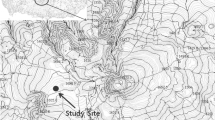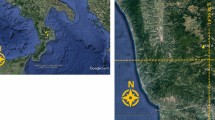Abstract
Accurate estimates of tree carbon, forest floor carbon and organic carbon in forest soils (SOC) are important in order to determine their contribution to global carbon (C) stocks. However, information about these carbon stocks is lacking. Some studies have investigated regional and continental scale patterns of carbon stocks in forest ecosystems; however, the changes in C storage in different components (vegetation, forest floor and soil) as a function of elevation in forest ecosystems remain poorly understood. In this study, we estimate C stocks of vegetation, forest floor and soils of a Pinus roxburghii Sargent forest in the Garhwal Himalayas along a gradient to quantify changes in carbon stock due to differences in elevation at three sites. The biomass of the vegetation changes drastically with increasing elevation among the three sites. The above-ground biomass (AGB) and below-ground biomass (BGB) were highest at site I (184.46 and 46.386 t·ha−1 respectively) at an elevation of 1300 m followed by site II (173.99 and 44.057 t·ha−1 AGB and BGB respectively) at 1400 m and the lowest AGB and BGB were estimated at site III (161.72 and 41.301 t·ha−1) at 1500 m. The trend for SOC stock was similar to that of biomass. Our results suggest that carbon storage (in both soil and biomass) is negatively correlated with elevation.
Similar content being viewed by others
References
Anonymous. 2004. Indian Council of Forestry Research and Education, Dehradun. Chir pine (Pinus roxburghii). Dehradun, Forest Research Institute. 21p. National Forest Library and Information Centre, FRI Dehradun, India
Bala G, Caldeira K, Wickett M, Phillips T J, Lobell D B, Delire C, Mirin A. 2007. Combined climate and carbon-cycle effects of large-scale deforestation. Proc Natl Acad Sci USA, 104(16), 6550–6555
Bitterlich W. 1984. The relaskop idea slough: Commonwealth Agricultural Bureause, Farnham Royal, England
Brown S L, Schrooder P, Kern J S. 1999. Spatial distribution of biomass in forests of the eastern USA. Forest Ecol Manage, 123(1): 81–90
Brown S, Lugo A E. 1984. Biomass of Tropical Forests: A New Estimate Based on Forest Volumes. Science, 223: 1290–1293
Brown S, Sathaye J, Cannell M, Kauppi P. 1996. Mitigation of carbon emission to the atmosphere by forest management. Commonw. Forest Rev, 75(1): 80–91
Brown S. 2002. Measuring carbon in forests: current status and future challenges. Environ Pollut, 116: 363–372
Cairns M A, Brown S, Helmer E H, Baumgardner G A. 1997. Root biomass allocation in the world’s upland forests. Oecologia, 111: 1–11
Canadell J G, Raupach M R. 2008. Managing forests for climate change mitigation. Science, 320: 1456–1457
Champion H G, Seth S K. 1968. Revised survey of Forest Types of India. Manager of Publications, Delhi
Dadhwal V K, Pandya N, Vora A B. 1998. ’Carbon Cycle for Indian Forest Ecosystem-A Preliminary Estimate’, Global Change Studies, Scientific Results from ISRO Geosphere-Biosphere Programme, India, ISRO, 411–429
Dey S K. 2005. A preliminary estimation of carbon stock sequestrated through rubber (Hevea brasiliensis) plantation in North Eastern regional of India. Ind Forest, 131(11): 1429–1435
Eswaran H, Reich P F, Kimble J M, Beinroth F H, Padmanabhan E, Moncharoen P. 2000. Global Carbon Stocks. In: Lal R, Kimble J M, Eswaran H, Stewart B A, eds. Global Climate Change and Pedogenic Carbonates, 15–25
FAO. 2005. Global forest resource assessment: progress towards sustainable forest management. In: Food and Agriculture Organisation Forestry Paper, vol. 147. FAO, Rome
Gairola S, Rawal R S, Todaria N P. 2008. Forest vegetation patterns along an altitudinal gradient in sub-alpine zone of West Himalaya India. Afr J Plant Sci, 2(6): 42–48
Garten C T, Post W M, Hanson P J, Cooper L W. 1999. Forest soil carbon inventories and dynamics along an elevation gradient in the southern Appalachian Mountains. Biogeochemistry, 45: 115–145
Hairiah K, Sitompul S M, Noordwijk M, Palm C. 2001. Methodology for sampling carbon stocks above and below ground. ASB Lecture Notes 4B. International Centre for Research in Agro forestry. Indonesia, Published in Dec., http://www.icraf.cgiar.org/sea. Accessed 15 Jan, 2012
Hardy F G, Syaukani Eggleton P. 2001. The effect of altitude and rainfall on the composition of termites (Isotera) of the Leuser ecosystem (Sumatra, Indonesia). J Trop Eco, 17: 379–393
Haripriya G S. 2000. Estimates of biomass in Indian forests. Biom Bioenerg, 19: 245–258
Hudson R J M, Gherini S A, Goldstein R A. 1994. Modeling the Global Carbon Cycle: Nitrogen Fertilization of the Terrestrial Biosphere and the “Missing” CO2 Sink. Global Biogeochem Cycles, 8: 307–333
IPCC. 1996. Climate Change 1995 Impacts, Adaptations and Mitigation of Climate: Scientific-Technical Analyses. In: Contribution of II to the Second Assessment Report of the Intergovernmental Panel on Climate Change. Cambridge University Press, UK
Jackson M L. 1958. Soil chemical Analysis Prentice Hall, Inc., Engle Wood Cliffs, New Jersey, USA
Johnson M G, Kern J S. 2002. Quantifying the organic carbon held in forested soils of the United States and Pueto Rico. In: Kimble J M, Heath L S, Birdsey R A, Lal R, eds. The Potential of U.S. Forest Soils to Sequester Carbon and Mitigate the Greenhouse Effects. Lewis Publishers, Boca Raton, FL
Kanjilal U N. 1928. Forest flora of the Chakrata, Dehra Dun and Saharanpur Forest Division, United Provinces, Govt. of India. Central Publications Branch, Calcutta
Korner C. 1998. A re-assessment of high elevation of tree line positions and their explanations. Oecologia, 115: 445–459
Koul D N, Panwar P. 2008. Prioritizing land-management options for carbon sequestration potential. Curr Sci, 95: 658–663
Lemenih M, Itanna F. 2004. Soil carbon stocks and turnovers in various vegetation type and arable lands along an elevation gradient in southern Ethiopia. Geoderma, 123: 177–188
Luyssaert, S, Schulze E D, Borner A, Knohl A, Hessenmoller D, Law B E, Ciais P, Grace P. 2008. Old growth forests as global carbon sinks. Nature, 455: 213–215
Malhi Y, Baldocchi D D, Jarvis P G. 1999. The carbon balance of tropical, temperate and boreal forests. Plant Cell Environ, 22: 712–740
Melillo J M, Hall D O, Agren, G I. 1996. Executive Summary. In: Breymeyer A I, Hall D O, Melillo J M, Agren G I, eds. Global Changes: Effects on Coniferous Forests & Grasslands, John Willey & Sons Pub, NY.
Nabuurs G J, Masera O, Andrasko K, Benitez-Ponce P, Boer R, Dutschke M, Elsiddig E, Ford-Robertson J, Frumhoff P, Karjalainen T, Kurz W A, Matsumoto M, Oyhantcabal W, Ravindranath N H, Sanz Sanchez M J, Zhang X. 2000. Forestry. In: Metz B, Davidson O R, Bosch P R, Dave R, Meyer L A, eds. Climate Change 2007: Mitigation. Contribution of III to the Fourth Assessment Report of the Intergovernmental Panel on Climate Change. Cambridge University Press, Cambridge, New York, 541–584
Odum E P. 1969. The strategy of ecosystem development. Science, 164: 262–270
Pressler M. 1895. Das Gesetz der Stambildung Leipzig, 153
Quideau S A, Chadwick Q A, Benesi A, Graham R C, Anderson M A. 2001. A direct link between forest vegetation type and soil organic matter composition. Geoderma, 104: 41–60
Ravindranath N H, Somashekhar B S, Gadgil M. 1997. Carbon flows in Indian forests. Climatic Change, 35: 297–320
Ravindranath N H, Somashekhar B S, Gadgil M. 1997. Carbon Flows in Indian Forests. Climte Change, 35: 297–320
Sah S P, Brumme R. 2003. Altitudinal gradients of natural abundance of stable isotopes of nitrogen and carbon in the needles and soil of a pine forest in Nepal. J For Sci, 49(1): 19–26
Sharma C M, Baduni N P, Gairola S, Ghildiyal S K, Suyal S. 2010. Tree diversity and carbon stocks of some major forest types of Garhwal Himalaya, India. Forest Ecol Manag, 260: 2170–2179
Sheikh M A, Kumar M, Bussmann R W. 2009. Altitudinal variation in soil organic carbon stock in coniferous subtropical and broadleaf temperate forests in Garhwal Himalaya. Carbon Balance and Management. doi:10.1186/1750-0680-4-6
Singh J S, Tiwari A K, Saxena A K. 1985. Himalayan forests: A net source of carbon to the atmosphere. Environ Conserv, 12: 67–69
Tandel M B, Kukadia M U, Kulambe B N, Jadeja D B. 2009. Influence of tree cover on physical properties of soil. Ind For, 135(3): 420–424
Walkley A, Black I A. 1934. An examination of the Degtiareff method for determining soil organic matter and proposed modification of the chromic acid titration method. Soil Sci, 63: 29–38
Watson R T. 2000. Land Use, Land-Use Change, and Forestry: A Special Report of the IPCC. Cambridge University Press, Cambridge, 377
Woomer P L. 1999. Impact of cultivation of carbon fluxes in woody savannas of southern Africa. Water Air soil Pollut, 70: 403–412
Author information
Authors and Affiliations
Corresponding author
Rights and permissions
About this article
Cite this article
Sheikh, M.A., Kumar, S. & Kumar, M. Above and below ground organic carbon stocks in a sub-tropical Pinus roxburghii Sargent forest of the Garhwal Himalayas. For. Stud. China 14, 205–209 (2012). https://doi.org/10.1007/s11632-012-0305-0
Received:
Accepted:
Published:
Issue Date:
DOI: https://doi.org/10.1007/s11632-012-0305-0




